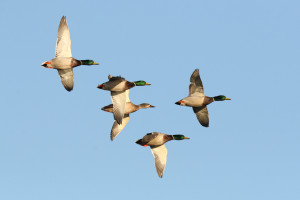Mallard Breeding Declined By 27 Percent

From the California Department of Fish and Wildlife
The California Department of Fish and Wildlife (CDFW) completed its 2015 waterfowl breeding population survey. The CDFW survey, which uses methodology approved by the U.S. Fish and Wildlife Service (USFWS), indicates the total number of breeding ducks (all species combined) has declined. Breeding mallards, the most numerous duck species in the state, declined 27 percent from 2014.
The total number of breeding ducks is estimated at 315,580, compared to 448,750 last year. The estimated breeding population of mallards is 173,865, a decrease from 238,670 in 2014. CDFW attributes the decline to very low precipitation and poor habitat conditions. Similar declines in breeding duck population estimates have occurred in the past but recovered after habitat conditions improved.
“Habitat conditions were poor the last three years in both northeastern California and the Central Valley and the production of young ducks was reduced as a result, so a lower breeding population was expected in 2015,” said CDFW’s Waterfowl Program Environmental Scientist Melanie Weaver. “We would expect another low year of duck production from these two important areas in California in 2015. However, habitat conditions in northern breeding areas (Alaska and Canada) are reported to be better than average.”
CDFW has conducted this survey using fixed-wing aircraft since 1948. The population estimates are for the surveyed areas only, which include the majority of the suitable duck nesting habitat in the state. These areas include wetland and agricultural areas in northeastern California, the Central Valley from Red Bluff to Bakersfield, and the Suisun Marsh. The Breeding Population Survey Report is available at www.dfg.ca.gov/wildlife/waterfowl/.
The majority of California’s wintering duck population originates from breeding areas surveyed by the USFWS in Alaska and Canada, and these results should be available in July. CDFW survey information, along with similar data from other Pacific Flyway states, is used by the USFWS and the Pacific Flyway Council when setting hunting regulations for the Pacific Flyway states, including California.
The federal regulation frameworks specify the outside dates, maximum season lengths and maximum bag limits. Once CDFW receives the USFWS estimates and the frameworks for waterfowl hunting regulations from the USFWS, CDFW will make a recommendation to the Fish and Game Commission regarding this year’s waterfowl hunting regulations.



